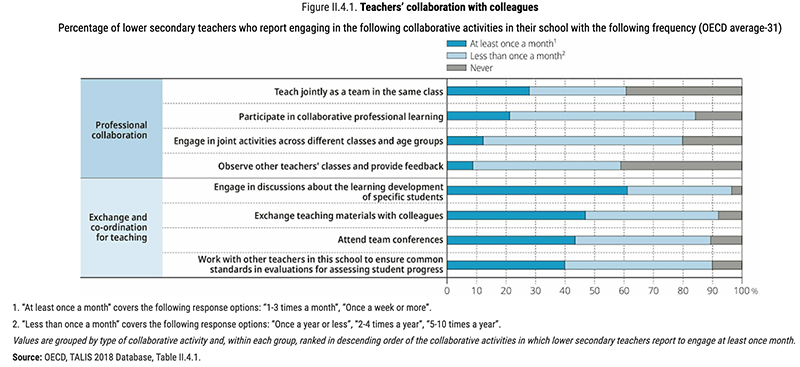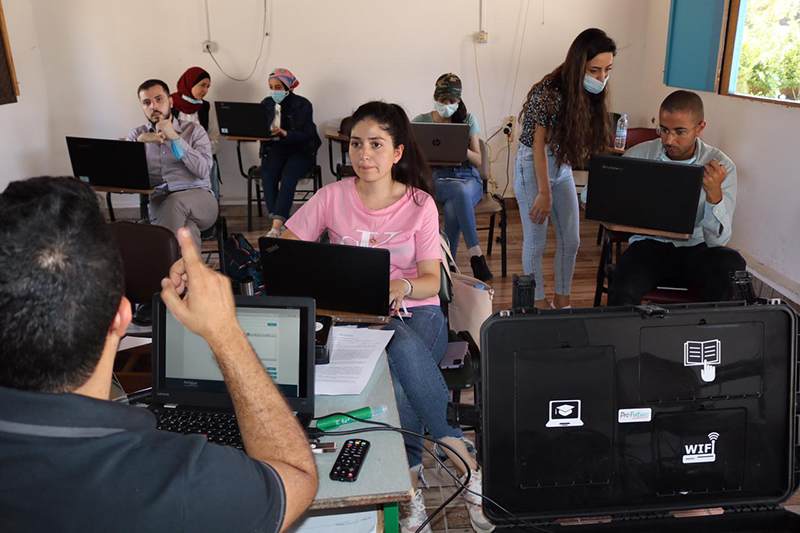*Cover photo courtesy of the American University of Beirut and Kayany Foundation.
Collaborative learning is in fashion. Its advantages for students, especially in the new educational paradigm context that is being imposed, have already been analysed in numerous forums. However, this way of learning also has advantages for teacher training. The digital era has made it much easier to develop proposals of this nature that favour peer tutoring and the creation of teacher virtual communities which, according to evidence, show excellent results for students and teachers. Between Teachers is one of these proposals. Below, we explain how it is articulated and what its main characteristics are.
The challenge of overcoming teacher isolation
Teachers feel left alone in their professional educational role. According to data available, this is particularly true for teachers in Southern European countries, Latin America and the Caribbean. According to the latest TALIS report (Teaching and Learning International Survey), produced by the OECD in 2018, teachers’ participation in collaborative activities is rare.
For example, on average across the OECD, 39% of teachers report having never taught joint classes, 16% report having never participated in collaborative professional learning, 20% report having never participated in joint activities between different classes and age groups, and 41% report having never observed other teachers’ classes or having provided feedback.
These percentages increase substantially in some countries and economies. For example, 75% of Spanish teachers, between 60% and 74% of teachers in Brazil, the autonomous city of Buenos Aires, Chile and Portugal; and between 50% and 59% of teachers in Colombia and Mexico have never given feedback on the observation of other teachers’ classes in their school.

Collaboration among teachers, according to TALIS. Source: TALIS, 2018 (OECD).
Evidence shows that teacher collaboration within the school is key to improving student achievement and helps teachers also improve at a faster rate (Ronfeldt et al., 2015). That is why, many governments around the world are promoting formal and informal collaborative systems. These efforts include networked learning cycles to encourage reflection in Singapore, Japan’s lesson study methodology or the teachers mentoring phenomenon in the United States, consisting of classroom observations followed by feedback and joint reflection between teacher and mentor (some projects include video recordings to identify improvement areas). Finally, the Finnish case stands out, where one of the keys to success lies in the collaboration between teachers in creating learning communities among students within the open environment (relating to their surroundings) of their schools (Kelly, Merry and González, 2018).
Between Teachers, community, observation and feedback for teachers’ support in their daily practice
It is in this context of teachers’ professional isolation, where Between Teachers was born, an online teacher training programme, which was born from a successful experience developed in 2016 jointly with Telefónica Foundation and Start by Educating. Between Teachers is based on a collaborative, hands-on learning philosophy that pursues two fundamental objectives:
- Provide practical training for teachers, from the classroom and for the classroom.
- And, generate a teacher learning community.
The programme’s intention is that, at its end, teachers become professionals with more effective work tools and have a real impact on their students, conceiving peer learning as a fundamental tool for their professional development and generate new spaces for learning experiences sharing.
The training consists of five modules:
- Observation and feedback: This introductory module covers the importance and usefulness of observing other teachers and to be observed by them, collecting, analysing and exchanging information about what happens in the classroom to improve teacher performance and, consequently, the students’ results. It introduces basic and important concepts such as observation. How to give feedback based on objective observation, and not based on personal interpretations, or what the learning communities are. A key module, introducing classroom observation methodology and basic working tools in all course modules, which teachers will then use to help their colleagues.
- Classroom management: in this module, we work on different classroom management techniques for a favourable learning climate. In addition, in this module as in all continuing modules, there is room for practice and for feedback among colleagues in the programme.
- Motivation: We know that motivation is key for children’s learning in complex situations. That’s why this module reflects on the importance of motivating students to be aware that they can do anything they set their minds to, and to change certain perceptions they have of themselves. Classroom strategies are designed to generate student motivation. The aim is to get students to understand the benefits of learning and what skills and abilities they have to achieve this.
- Planning: While it is true that teachers are used to planning, the goal of this module is to reflect on the importance of classroom planning being closely aligned with learning objectives. Different tools are used, valid for all educational levels, in order to learn to plan with a purpose in mind, with a goal. In addition, there is analysis and reflection on how the teacher’s actions influence the students’ actions, in order to try to take advantage of this and make the most of classroom learning time.
- Verification of learning, it is very common among teachers to believe that all students have understood the explanation, and then the exercises or exams do not have the expected outcome. In this module, different techniques will be learned to ask rigorous questions to all students, with which useful information about their learning levels will be obtained, thus creating new learning opportunities for all.
Each of these modules is structured in phases as follows:
- The content is presented with readings, videos, reflections, discussions and assignments.
- The teacher assimilates what was learned and puts it into practice in the classroom for three weeks (learning by doing methodology).
- When he or she feels confident, the teacher records a lesson using one of the techniques learned and shares the video with two other colleagues involved in the same learning process, who will feed back through a standardised heading.
- Individual and collective learning is generated from this dynamic focused on community sharing based on what is practised, and not on what is thought or commented on.
All modules end with an evaluation of module objectives that facilitate the continuous improvement of the proposal’s content.

Source: ProFuturo Foundation & Empieza por Educar. (2020). Entre Profes. Una mirada desde la práctica. Manual de acompañamiento.
Mass digitisation in all environments and life aspects expands our possibilities for everyday improvement, through innovative learning methodologies and environments. Teachers must be at the forefront of innovation and change in professional habits, encouraging hybridisation of education with technology. For this, peer collaboration is essential. Technology enables unrestricted time and place cooperation, recovering the value of peers and cooperative learning (Fernández Enguita, n.d.). Between Teachers as well.
REFERENCES
Fernández Enguita, M. (2020). Del aislamiento en la escuela a la codocencia en el aula: enseñar es menos colaborativo que aprender o trabajar, y debe dejar de serlo. Participación educativa. 2020, segunda época, vol. 7, n. 10, mayo; p. 15-28.
Fundación ProFuturo. (2018). Entre Profes. Una mirada desde la práctica. Manual de implantación y resumen de buenas prácticas. Fundación Telefónica y Fundación La Caixa.
Fundación ProFuturo y Fundación Empieza por Educar. (2020). Entre Profes. Una mirada desde la práctica. Manual de acompañamiento. Fundación Telefónica y Fundación La Caixa.
Kelly, K., Merry, J. y González, M. (2018). Trust, collaboration, and well-being: lessons learned from Finland. SRATE Journal 27(2). Summer 2018 Edition.
OECD. (2018). TALIS 2018 Results (Volume II). Teachers and School Leaders as Valued Professionals. TALIS, OECD Publishing, Paris, https://doi.org/10.1787/19cf08df-en.






